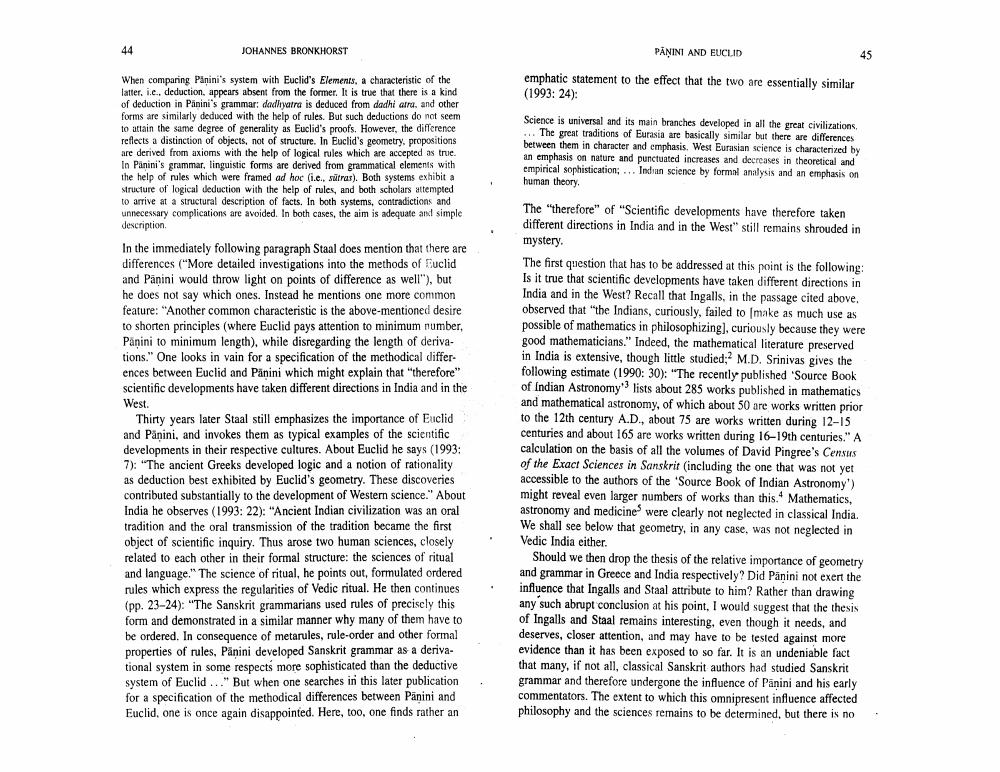Book Title: Panini And Euclid Reflections On Indian Geometry Author(s): Johannes Bronkhorst Publisher: Johannes Bronkhorst View full book textPage 2
________________ 44 JOHANNES BRONKHORST When comparing Pänini's system with Euclid's Elements, a characteristic of the latter, i.e., deduction, appears absent from the former. It is true that there is a kind of deduction in Panini's grammar: dadhyatra is deduced from dadhi atra, and other forms are similarly deduced with the help of rules. But such deductions do not seem to attain the same degree of generality as Euclid's proofs. However, the difference reflects a distinction of objects, not of structure. In Euclid's geometry, propositions are derived from axioms with the help of logical rules which are accepted as true. In Panini's grammar, linguistic forms are derived from grammatical elements with the help of rules which were framed ad hoc (ie., sutras). Both systems exhibit a structure of logical deduction with the help of rules, and both scholars attempted to arrive at a structural description of facts. In both systems, contradictions and unnecessary complications are avoided. In both cases, the aim is adequate and simple. description. In the immediately following paragraph Staal does mention that there are differences ("More detailed investigations into the methods of Euclid and Panini would throw light on points of difference as well"), but he does not say which ones. Instead he mentions one more common feature: "Another common characteristic is the above-mentioned desire to shorten principles (where Euclid pays attention to minimum number, Panini to minimum length), while disregarding the length of derivations." One looks in vain for a specification of the methodical differences between Euclid and Panini which might explain that "therefore" scientific developments have taken different directions in India and in the West. Thirty years later Staal still emphasizes the importance of Euclid and Panini, and invokes them as typical examples of the scientific developments in their respective cultures. About Euclid he says (1993: 7): "The ancient Greeks developed logic and a notion of rationality as deduction best exhibited by Euclid's geometry. These discoveries contributed substantially to the development of Western science." About India he observes (1993: 22): "Ancient Indian civilization was an oral tradition and the oral transmission of the tradition became the first object of scientific inquiry. Thus arose two human sciences, closely related to each other in their formal structure: the sciences of ritual and language." The science of ritual, he points out, formulated ordered rules which express the regularities of Vedic ritual. He then continues (pp. 23-24): "The Sanskrit grammarians used rules of precisely this form and demonstrated in a similar manner why many of them have to be ordered. In consequence of metarules, rule-order and other formal properties of rules, Pänini developed Sanskrit grammar as a derivational system in some respects more sophisticated than the deductive system of Euclid..." But when one searches in this later publication for a specification of the methodical differences between Pänini and Euclid, one is once again disappointed. Here, too, one finds rather an PANINI AND EUCLID emphatic statement to the effect that the two are essentially similar (1993: 24): 45 Science is universal and its main branches developed in all the great civilizations. ...The great traditions of Eurasia are basically similar but there are differences between them in character and emphasis. West Eurasian science is characterized by an emphasis on nature and punctuated increases and decreases in theoretical and empirical sophistication;... Indian science by formal analysis and an emphasis on human theory. The "therefore" of "Scientific developments have therefore taken different directions in India and in the West" still remains shrouded in mystery. The first question that has to be addressed at this point is the following: Is it true that scientific developments have taken different directions in India and in the West? Recall that Ingalls, in the passage cited above. observed that "the Indians, curiously, failed to [make as much use as possible of mathematics in philosophizing], curiously because they were good mathematicians." Indeed, the mathematical literature preserved in India is extensive, though little studied;2 M.D. Srinivas gives the following estimate (1990: 30): "The recently published 'Source Book of Indian Astronomy13 lists about 285 works published in mathematics and mathematical astronomy, of which about 50 are works written prior to the 12th century A.D., about 75 are works written during 12-15 centuries and about 165 are works written during 16-19th centuries." A calculation on the basis of all the volumes of David Pingree's Census of the Exact Sciences in Sanskrit (including the one that was not yet accessible to the authors of the 'Source Book of Indian Astronomy") might reveal even larger numbers of works than this.4 Mathematics, astronomy and medicines were clearly not neglected in classical India. We shall see below that geometry, in any case, was not neglected in Vedic India either. Should we then drop the thesis of the relative importance of geometry and grammar in Greece and India respectively? Did Pänini not exert the influence that Ingalls and Staal attribute to him? Rather than drawing any such abrupt conclusion at his point, I would suggest that the thesis of Ingalls and Staal remains interesting, even though it needs, and deserves, closer attention, and may have to be tested against more evidence than it has been exposed to so far. It is an undeniable fact that many, if not all, classical Sanskrit authors had studied Sanskrit grammar and therefore undergone the influence of Panini and his early commentators. The extent to which this omnipresent influence affected philosophy and the sciences remains to be determined, but there is noPage Navigation
1 2 3 4 5 6 7 8 9 10 11 12 13 14 15 16 17 18 19 20
